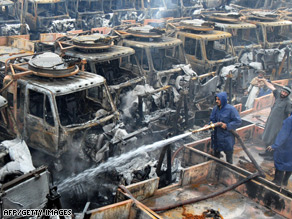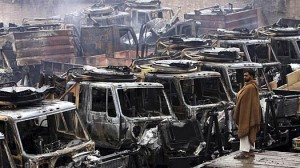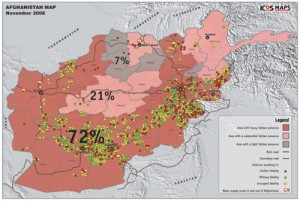In what might be the clearest tale to date about SOF narcissism over the Afghanistan high value target campaign, we see that the gaming goes nearly to the top in a recent report at the Army Times (hotel tango SWJ Blog).
Defense Secretary Robert Gates’ plan to deploy three additional combat brigades to Afghanistan by the summer has superseded a contentious debate that pitted the Bush administration’s “war czar” against the special operations hierarchy over a proposed near-term “surge” of spec ops forces to Afghanistan, a Pentagon military official said.
The National Security Council’s surge proposal, which grew out of its Afghan strategy review, recommended an increase of “about another battalion’s worth” of troops to the Combined and Joint Special Operations Task Force-Afghanistan, or CJSOTF-A, said a field-grade Special Forces officer, who added that this would enlarge the task force by about a third.
Several sources said that the “SOF surge” proposal originated with Lt. Gen. Doug Lute, the so-called “war czar” whose official title is assistant to the president and deputy national security adviser for Iraq and Afghanistan policy and implementation. The rationale behind deploying more special ops forces to Afghanistan was that any decision to deploy more conventional brigades to Afghanistan would take at least several months to implement, whereas special ops units could be sent much more quickly, the Special Forces officer said.
Not likely. Afghanistan has been a SOF campaign from the beginning, and the lack of force projection and confused mission have led us to where we are. It’s hard to believe that the power structure suddenly decided on a SOF surge, since SOF surging is what has been happening for seven years. Furthermore, there is always CENTCOM ready reserve which is usually comprised of a MEU. But continuing:
… the proposal sparked a fierce high-level debate, with special operations officers charging that Lute and his colleagues were trying to micromanage the movement of individual Special Forces A-teams from inside the Beltway, and countercharges that Special Forces has strayed from its traditional mission of raising and training indigenous forces and become too focused on direct-action missions to kill or capture enemies.
Most major special operations commands were opposed to the proposal, special operations sources said. The sources identified U.S. Special Operations Command, U.S. Army Special Operations Command and the office of Assistant Secretary of Defense for Special Operations, Low-Intensity Conflict and Interdependent Capabilities, headed by Michael Vickers, as all resisting the initiative.
Special operations sources said that those opposing the “SOF surge” were generally against the idea on two grounds: that the commander of U.S. and NATO forces in Afghanistan, Gen. David McKiernan, has not requested them, and that the CJSOTF-A does not have enough “enablers” — such as helicopters and intelligence, surveillance and reconnaissance assets — to support the forces it has in-country now, let alone another battalion’s worth.
Strayed indeed. Kinetic operations against high value targets – for whatever worth this has been – don’t require SOF. It might be that there is something deeper here. Lt. Gen. Lute certainly must know that Afghanistan cannot continue to be a SOF campaign against HVTs, and the SOF command must certainly know that the beast of Operation Enduring Freedom has grown far beyond what they are able to bear. If it’s a question of who will break first and say these things, then such gamesmanship over serious military operations is loathsome and detestable. But it gets even better (or worse).
The short supply of helicopters in Afghanistan has been a constant problem for conventional forces and CJSOTF-A, the “white,” or unclassified, task force in-country. Unlike the secretive, “black,” Joint Special Operations Command task force, which is directly supported by elements of the 160th Special Operations Aviation Regiment, “white” Special Forces groups do not have their own dedicated aviation units and have to compete for helicopter support with the rest of the U.S. and allied forces in Afghanistan. CJSOTF-A is commanded by a colonel, whereas the other organizations are all commanded by flag officers.
The Pentagon military official said that the planned deployment of an additional 20,000 conventional U.S. troops, including three brigade combat teams, to Afghanistan would also include a lot of “enablers” that the special operations forces could use.
The Pentagon plan includes more helicopters being sent to Afghanistan, as well as the possibility of a one-star special operations flag officer to command “white” SOF forces in country, which would obviate the need to have “O-6s arm wrestling with O-7s and O-9s,” he said.
More politics, and make sure to take notice of what SOF command sees as the mission for these additional “enablers.” They would go to SOF (‘a lot of “enablers” that the special operations forces could use’). Finally:
A field-grade officer in Washington who has been tracking the debate said that the “white” SOF leaders’ argument that their forces need more ISR assets and helicopters is a reflection of how Special Forces has veered from its traditional mission of “foreign internal defense” — training host nation forces to conduct counterinsurgency — in favor of the more glamorous direct-action missions.
The officer said Lute believes that special operations forces, particularly Special Forces, “are the right force” to send to Afghanistan because of their skills at teaching foreign internal defense.
This might explain the special operations hierarchy’s opposition to Lute’s surge proposal, the field grade-officer in Washington said. “This is an implicit criticism of what SOF has done for the last five years,” he said. “They haven’t been training indigenous forces. That may be what SOCOM is objecting to, is it’s implicitly a critique of SOF’s over-fascination with direct action.”
It has come full circle, from Lute’s belief that training some Afghan soldiers can solve the problem – or so says the source – to the potential that this proposition is a critique of the evolved SOF mission and a charade, to the campaign that has grown beyond anything that the SOF can possibly handle alone.
Regular readers of The Captain’s Journal know our position, and we believe that this political maneuvering is disgusting and despicable. The SOF navel-gazing is embarrassing, and it’s time for both the SOF and the American public to graduate beyond the Rambo understanding of irregular warfare where a SOF operator or two is turned loose in the jungles or deserts and the whole world changes in a day or two because of the thousands of rounds discharged from his weapon.
Really. This is the stuff of children, adolescents and un-reformable movie-goers. Can’t we be more serious about our military strategy than this? Afghanistan will require political and financial investment, force projection (Army and Marines), and – yes – SOF too. SOF performs an invaluable role in small footprint international force projection, with their special skills in language training and similar “enablers” for their mission. But the daydream of creating a few extra SOF operators to do the dirty work and returning the Army and Marines stateside is just that. A daydream. A small footprint for seven years is why OEF looks the way it does. We need more serious reflection than that to build the strategies for the future.
Prior:
Concerning Turning Over Afghanistan to Special Operations Forces
60 Minutes and the Special Forces Hunt for Bin Laden
The Cult of Special Forces
Another Disappointing RAND Counterinsurgency Study
Please take time to answer the poll question:

 .
.



